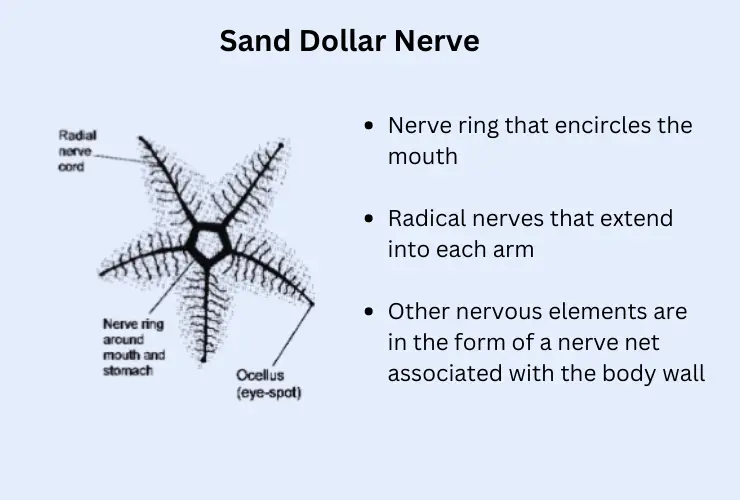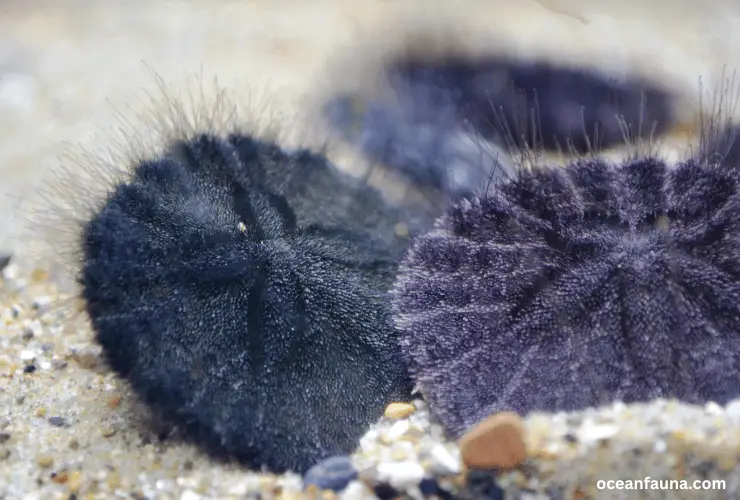The straightforward answer is NO. Sand dollars don’t have a brain. Instead, they have a nerve net called the nerve ring. It is present around the pharynx and helps to regulate body functions and convey signals.
So, these tiny creatures lack a proper brain and central nervous system. FEELING DUMBFOUND? In fact, all invertebrates belonging to phylum Echinodermata don’t have a properly developed brain.
Now, let’s dive into the article and unravel some more mind-boggling facts about sand dollars.
Do Sand Dollars Have a Brain?
No!
Sand dollars don’t have a brain or central nervous system.
The nervous system of sand dollars, like other echinoderms, has been observed since the embryo stage.
When the baby sand dollar changes into larvae, the embryonic sand dollar undergoes expansion and is known as the larval nervous system. It is centered around the ciliary bands of larvae.

Later, the larval nervous system also changes when it metamorphoses into adult sand dollars. It consists of a nerve net of two intraepidermal nerve rings around the pharynx with nervous cords extending along the arms.
Also Read: What Is Inside A Sand Dollar? Discover Its Anatomy
The best part about all echinoderms is that they can regenerate their nervous system.
What Is a Nerve Ring Composed of?
The nerve ring is a ring of nervous tissues and interconnecting neurons. It is present around the pharynx and esophagus of the sand dollars.
All members of Phylum Echinodermata have a quite simple nervous system based on nerve rings only.

The ring is present along the mouth, and the nerves extend along the arms of the organisms.
Although much simpler than the brain and has limited function, nerve rings help sense touch and coordinate body movements.
What Is the Difference Between A Brain And A Nerve Ring?
The difference between the brain and the nerve ring is the evolution period.
The nerve ring is a much simpler form of the nervous system. It contains only a network of interconnected neurons. However, it has no ganglia or other components to coordinate body functions.
On the other hand, the brain is the most advanced form of CNS. It helps coordinate movements, control emotions, feel receptors, etc.
Its composition is rich in nerves, neurons, blood vessels, and glial cells.
How Does the Nerve Ring Function In Sand Dollars?
A fully functional, well-developed brain didn’t develop by the time of the evolution of Phylum Echinodermata. Instead, the primitive form of the brain called the nerve ring was present.
The ring relays sensory and motor signals throughout the sand dollar body and helps perform the roles of a nervous system to so extent.
● Sensory Abilities
Although sand dollars don’t have eyes, the nerve ring helps to transfer and govern sensory responses.
For example, there are chemoreceptors on bodies on sand dollars. These receptors transfer signals to the nerve ring whenever they find a predator approaching. Then the nerves coordinate to move away from the predator.
Moreover, these nerves coordinate tube feet and cilia. In this way, it helps sand dollars to move in perfect rhythm along the seafloor.
● Eating
These neurons are present around the mouth. They are known to open and close mouth loops and thus control the entry of food particles.
Is The Brain of a Sand Dollar Similar To That of A Sea Urchin?
Yes!
The brain of a sand dollar is quite similar to that of a sea urchin.
Also Read: Do Sea Urchins Have Brains?
Both sand dollars and sea urchins don’t possess a central nervous system.
Instead, they only have a sparse network of nerves, which we term the nerve ring.
Do Sand Dollars Have a Heart?
No!
Sand dollars don’t have a heart. They have no blood supply even. Therefore, there remains no need for a heart.
However, they have cilia, tube feet, and spines present on the test of sand dollars.
These components help to push water through the bodies of sand dollars, thus allowing sand dollars to extract the oxygen required for respiration.
Is The Nervous System of A Sand Dollar Similar To The Human Nervous System?
No!
The nervous system of sand dollars is quite different from that of humans.

Where the sand dollar consists of only a few neurons that merge to form nerve rings, human brains are far more complex.
It is composed of three main parts:
- Forebrain
- Midbrain
- Hindbrain
Each part consists of neurons, ganglia, cranial, and spinal nerves.
They perform various functions in humans, which include controlling
- Thoughts and emotions
- Movements and coordination
- Perception of senses
- Regulation of organ and organ functions
- Automatic behavior
- Ability to speak and learn
- Temperature regulation
What Other Organs Does a Sand Dollar Not Have?
Sand dollars belong to the phylum Echinodermata of invertebrates. Therefore, they are much simpler organisms with less developed or no complex organs and organ levels.
Here is a list of organs that a sand dollar lacks:
- Eyes
- Brain
- Heart
- Lungs
- Blood
- Circulatory system (except for the vascular system)
- Backbone
Frequently Asked Questions (FAQs)
Q.1 What is present inside a sand dollar?
Five dove-shaped teeth are present inside the sand dollars. They are called doves and are marked as symbols of love and peace. Breaking sand dollars is believed to add peace and tranquility to one’s life.
Q.2 Do sand dollars have eyes?
No!
Sand dollars don’t have eyes. However, other echinoderms have compound eyes or eyespots.
Sand dollars use their sensory and chemical receptors to catch prey and escape the eye of predators.
Q.3 Are sand dollars cold-blooded organisms?
No!
Sand dollars are neither cold-blooded nor warm-blooded organisms. In fact, they have no blood.
Q.4 Why do sand dollars have cilia?
Sand Dollars have cilia present on the test.
Cilia aids the spines with catching food particles and transferring them to the mouth.
Q.5 Do sand dollars have organs?
Yes!
Sand Dollars have various organs, which include spines, cilia, pedicellariae, movable jaw with teeth, tube feet, mouth, anus, and many more.
Final Verdict
Sand dollars don’t have a brain. Instead, they have a set of various interconnected neurons. These neurons combine to form a nerve ring around the pharynx of the body. These nerves help to coordinate the body and allow rhythmic movements.
However, their nervous system is quite different and less developed than humans.


1 thought on “Do Sand Dollars Have Brains? [No, Here’s Why]”